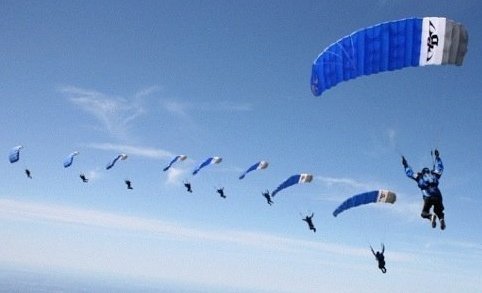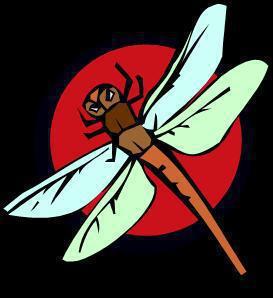Recommended Posts
chuckakers 426
QuoteYou should read Missy Nelsons safety tip on the chicago site.
Now there's a bit of irony, eh?
.Chuck Akers
D-10855
Houston, TX
Exactly why it was posted.
Maybe we could all learn from that experience. It'd be a shame to let that go to waste.
Blue skies
Ian
Maybe we could all learn from that experience. It'd be a shame to let that go to waste.
Blue skies
Ian
Performance Designs Factory Team
tictoc 0
QuoteYou should read Missy Nelsons safety tip on the chicago site.
Nice post
--------------------------------------------------------
Some one must go to the edge for others to be able to find it. But if you go be sure you can make it back.
Some one must go to the edge for others to be able to find it. But if you go be sure you can make it back.
sducoach 0
James 4:8
Shark 0
Does the lower canopy have the right-of-way?
kyros1 0
Always
kyros1 0
On SIM of USPA there some really explainatory graphs regarding landing patterns. It might be very difficult for everybody to keep a left hand pattern (in case that there are many canopies on the air), but I believe that we should keep some principals like no S turns, no spiraling down and try to keep some vertical and horizontal seperation. What I prefer to do is when I open I dont unstow brakes and I leave traffic below me. If somenone got a faster canopy than me I give him all the way to go and land first.
Tonto 1
We have a landing pattern but few people understand it. The zig zagging you describe in your senario is quite common. We're working on a program to better educate all our canopy pilots.
t
t
It's the year of the Pig.
Every DZ that has even the smallest quantity of small, performance mains now has to do their best to work solutions. Here at Raeford we have a designated "high performance" lane and we teach, ad nauseum, that it's everyone's responsibility to keep their head on a swivel. While our landing pattern is generally left-hand, those doing HP landings generally end up doing a right 270 off of base from a higher altitude. It's my opinion as the S&TA here that this is a fine working solution, so long as I don't have any errant, non-briefed jumpers flying across the HP lane at 400 feet on base. I have just moved our HP lane out to what I believed to be a "safer" area, but now am reconsidering the move, as it put the entrance gates sqarely under the base leg for "non-HP" traffic; probably not too bright, but we will figure it out in a DZ meeting sometime this week. There must be some balance between your student, "standard", target accuracy, and HP traffic. The "old" rules of the air still apply, obviously, but everyone, including "the lower jumper" needs to be vigilant. Spiralling your Stilletto 120 down well below 1000 feet then toggle whipping it at 250 feet just to beat four guys on much smaller Velocities to the swoop lane is assinine. This, especially when you know that those other four guys throw their carves at between 700 and 900 feet. Stilleto man would have been much smarter to just chill out and wait for those guys to pass him at altitude and let them throw their turn. Then, he would still have sufficient altitude to setup for a clean run through the course without fear of being overrun. We have it even more freaky here what with the high number of demonstation teams practicing on the same DZ, plus the GK style and accuracy guys setting up for the tuffet. Communication is key to safety. Good briefings to new and visiting jumpers help, but gathering the masses for occasional meetings is what keeps "regulars" who have just not ever had to worry about mixed traffic before understand that there are new variables that affect all of us. As the equipment grows more and more different with each discipline (we used to all do CRW with whatever we had in our pack tray at the time), then so must our landing guidance. Communication and education are key to safety.
Sincerely,
Chuck Blue
D-12501
Manager, Raeford Parachute Center School
AFF/SL/TM/BM-I, PRO, S&TA
Sincerely,
Chuck Blue
D-12501
Manager, Raeford Parachute Center School
AFF/SL/TM/BM-I, PRO, S&TA
How big is this landing area?
I have YET to see a DZ where the landing area is so small there aren't any outs. I've landed in many a backyard as well...
-- (N.DG) "If all else fails – at least try and look under control." --
I have YET to see a DZ where the landing area is so small there aren't any outs. I've landed in many a backyard as well...
-- (N.DG) "If all else fails – at least try and look under control." --
I had no idea that S-turns were such bad juju.  I guess I'll stop!
I guess I'll stop!
A One that Isn't Cold is Scarcely a One at All
It's not that S-turns are directly bad juju - so use them if you absolutely need to. But once the landing is done re-evaluate why you needed to use them (normally turning in too early) and try not to make the same mistakes on the next jump.
Blue skies
Ian
Blue skies
Ian
Performance Designs Factory Team
Enano 0
QuoteAlways
yep, but how many time have you see other canopies above you holding down the toggle to lose altitude and not respecting the right of way???
42 and don't forget your towell
kyros1 0
Very very rare.





S turns while valid are inconsiderate to those behind you. While I have no problem with those that make them occasionally to fix altitude problems, I have a HUGE issue with those that use them all the time without re-evaluating their flight pattern for the conditions (and yes we have a small landing area so s turns can effectively cut off almost all jumpers coming in behind them).
Blue skies
Ian
Share this post
Link to post
Share on other sites